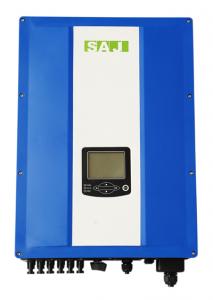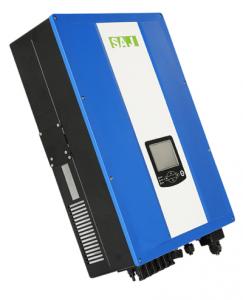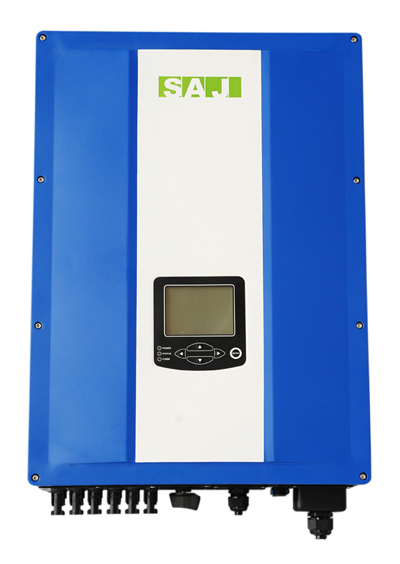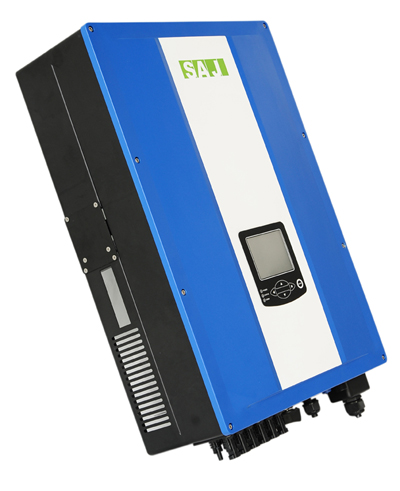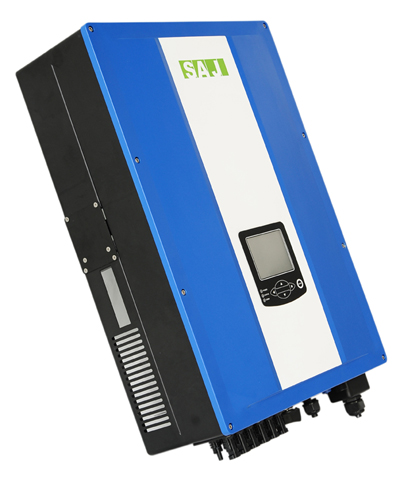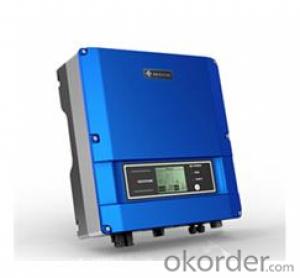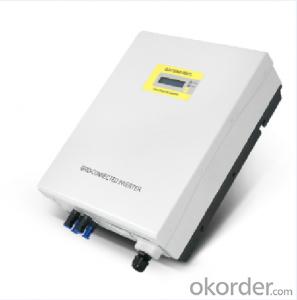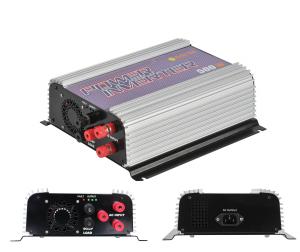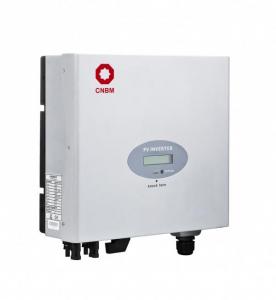Solar Inverter Manufacturers:On Grid Solar Inverter Suntrio-TL15K with 2 MPPT
- Loading Port:
- Guangzhou
- Payment Terms:
- TT OR LC
- Min Order Qty:
- 1 watt
- Supply Capability:
- 3000 watt/month
OKorder Service Pledge
OKorder Financial Service
You Might Also Like
Suntrio-TL12K/15K/17K/20K PV inverters are transformerless inverters with efficiency of up to 98.1%. Multi-MPPT inputs provides higher flexibility for the project installation. Stainless steel housing and IP65 protection guarantee use both indoor and outdoor for long. The series inverters are ideally suited for medium and commercial PV projects of up to MW range.
1. Leading technology
· Max. efficiency 98.1%
• MPPT accuracy up to 99.9% efficiency
• Compliant with VDE-AR-N 4105
2. User-friendly
• 5 inch LCD display with comprehensive information
• Embedded webserver monitoring
• Easy installation
3. Flexible
• Multi-country configuration
• RS485 / Ethernet / Wi-Fi communication
• Wide range of DC input voltage
• IP65 for indoor and outdoor
4. Certificates: TUV,SAA,G83,ISO9001,ISO14001,etc.
Futures
■ Two independent MPPT for flexible configuration.
■ Space Vector PWM to maximize efficiency and minimize EMI.
■ Highest MPPT performance, up to 99.9% efficiency.
■ Transformerless design with 98.1% Max. efficiency.
■ Ethernet/ Wi-Fi communication interface.
■ Integrated Web Server for overall performance monitoring.
■ Compliance with VDE-AR-N 4105 with reactive power control.
■ 5-inch large LCD display.
■ LCD day/month/year/total yield graphs display.
■ Event history lookup
■ Easy operation with 5 navigation buttons.

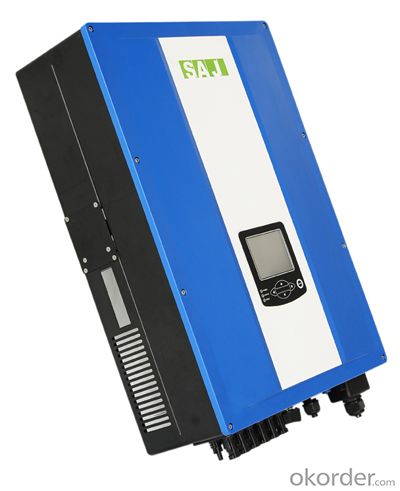
FAQ
1. How long will my inquiry get response?
Your inquiry related to our products or prices will be replied within 24 hours.
2. Can I get professional service and suggestion?
Well-trained and experienced staffs to answer all your questions in fluent English.
3. Do you accept OEM or customized design?
OEM & ODM, any your customized lightings we can help you to design and put into product.
4. What if I need specific design?
Distributorship are offered for your unique design and some our current models.
- Q: How does the input frequency range affect the performance of a solar inverter?
- The input frequency range directly affects the performance of a solar inverter. A wider input frequency range allows the inverter to efficiently convert a broader range of solar panel output frequencies into usable electricity. This flexibility ensures that the inverter can effectively handle varying solar panel output and maintain stable and reliable power conversion. Conversely, a limited input frequency range may result in poor performance, reduced efficiency, and potential instability or failure of the inverter under certain conditions.
- Q: How does a solar inverter handle voltage drop?
- A solar inverter handles voltage drop by continuously monitoring the voltage levels from the solar panels. It adjusts its output voltage accordingly to ensure that the electricity being produced is compatible with the grid or the appliances it is connected to. This helps to compensate for any voltage drop that may occur due to factors such as distance, resistance, or shading, thereby maintaining a consistent and stable power supply.
- Q: Installation and maintenance of photovoltaic grid - connected inverter
- Before the installation should first check whether the inverter in the transport process for damage. When selecting the installation site, there should be no interference with any other power electronic equipment in the surrounding area.
- Q: Can a solar inverter be used with different types of solar panels (monocrystalline, polycrystalline, thin-film)?
- Yes, a solar inverter can be used with different types of solar panels, including monocrystalline, polycrystalline, and thin-film. The key factor is that the solar panels need to have compatible voltage and current ratings with the inverter. As long as the specifications match, the inverter can efficiently convert the DC power generated by any of these solar panel types into usable AC power for various applications.
- Q: PV grid-connected inverter can directly load it?
- Grid-connected inverter is usually equipped with island protection function, can only receive the power grid, if the load directly, the output is disconnected.
- Q: What is the maximum output power of a solar inverter?
- The maximum output power of a solar inverter varies depending on the specific model and its capacity. However, typical residential solar inverters have a maximum output power ranging from 1 kilowatt (kW) to 10 kW, while commercial and utility-scale solar inverters can have maximum output powers exceeding several megawatts (MW).
- Q: Can a solar inverter be used with solar-powered outdoor lighting?
- Yes, a solar inverter can be used with solar-powered outdoor lighting. The solar inverter is responsible for converting the direct current (DC) produced by the solar panels into alternating current (AC) that is suitable for powering outdoor lighting fixtures. By using a solar inverter, the solar energy collected during the day can be efficiently utilized to power outdoor lighting systems during the night.
- Q: What is the difference between a central inverter and a string inverter?
- A central inverter is a type of inverter that is used in large-scale solar installations. It takes the direct current (DC) electricity generated by multiple solar panels and converts it into alternating current (AC) electricity that can be used to power homes or businesses. A central inverter is typically located in a central location, such as a utility room or basement. On the other hand, a string inverter is a type of inverter that is used in smaller-scale solar installations. It also converts DC electricity from multiple solar panels into AC electricity, but it does so at the string level. This means that each string of solar panels has its own dedicated inverter. String inverters are usually installed near the solar panels themselves, which can make them more convenient for maintenance and troubleshooting. In summary, the main difference between a central inverter and a string inverter is the scale of the solar installation they are used in and their physical location. Central inverters are used in larger installations and are located centrally, while string inverters are used in smaller installations and are located near the solar panels.
- Q: What are the key features to consider when choosing a solar inverter?
- When choosing a solar inverter, some key features to consider are the inverter's efficiency, maximum power point tracking (MPPT) capability, warranty and reliability, communication capabilities, and compatibility with your solar panels and battery system (if applicable).
- Q: Is the PV inverter a current source or a voltage source?
- According to the waveform modulation method can be divided into square wave inverter, stepped wave inverter, sine wave inverter and modular three-phase inverter.
Send your message to us
Solar Inverter Manufacturers:On Grid Solar Inverter Suntrio-TL15K with 2 MPPT
- Loading Port:
- Guangzhou
- Payment Terms:
- TT OR LC
- Min Order Qty:
- 1 watt
- Supply Capability:
- 3000 watt/month
OKorder Service Pledge
OKorder Financial Service
Similar products
Hot products
Hot Searches
Related keywords
